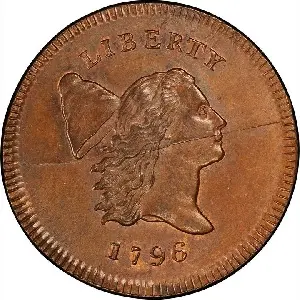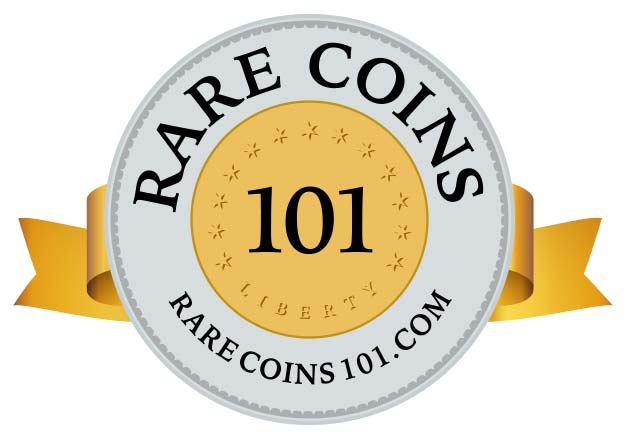1796 Liberty Cap, Facing Right Half Cent, No Pole
The year 1796 was a milestone at the nascent United States Mint in Philadelphia, for it was the first year every coin denomination specified by the Mint Act of 1792 saw production, from the half cent to the $10 eagle.(1)
This accomplishment almost didn’t happen, as the lowly half cent barely got on the scoreboard… just 1,390 pieces were struck (although there is some evidence to suggest the mintage of 1796 half cents may have been as “high” as 6,480).
There are two varieties of the 1796 Liberty Cap, Facing Right half cent. One shows a pole behind Miss Liberty, topped by a liberty cap. On the other variety, the pole is absent, because for whatever reason, the engraver simply did not punch it into the die. Both obverses were paired with a single reverse die.
To learn about the symbolism of the liberty cap and pole, see the 1793 Liberty Cap, Facing Left half cent.
Roger Cohen, Jr., in his widely read 1971 publication American Half Cents, dubbed the 1796 half cent varieties the “Little Half Sisters.” We will probably never ascertain which sister was “born” first.
While it is true the “No Pole” and “With Pole” obverses shared the same reverse, because so few were struck, the reverse die did not wear down enough for analysists to detect deterioration, and thus an emission sequence cannot be demonstrated.
Of the two, the “No Pole” variety is more difficult to find, though both are extremely rare and desirable.
The reason the 1796 No Pole is so scarce is related to the sizeable crack the obverse die suffered from side to side horizontally. The cracking may have occurred as the die was being readied during the heat treat process. It is also possible it fractured after the first few coin strikes.(2)
Since the die was severely damaged, production didn’t or couldn’t continue for long before the die was removed from service, explaining the very limited mintage of “No Pole” half cents. All known surviving examples of this variety, of which PCGS estimates to total 30, display the conspicuous crack.(3)
Both varieties of the 1796 half cent are revered as classic rarities by numismatists everywhere. Although the “half-sisters” may not skyrocket in value as much as other coins on the Key Date List, the data from 1950 to the present show consistent gains – just as expected for a coin of great rarity, importance, and historical significance.
| Estimated survivors in all grades: 30 ?
The survivor estimate from PCGS represents an average of one or more experts' opinions as to how many examples survive of a particular coin in all grades. Survival estimates include coins that are raw, certified by PCGS, and certified by other grading services. Learn more at PCGS. |
| PCGS Rarity Scale: 8.9 ?
The 'PCGS CoinFacts Rarity Scale' assesses the relative rarity of all U.S. coins, based on estimated surviving examples. The scale runs from 1.0 to 10.0. The higher the number, the rarer the coin.
Learn more at PCGS. |
| Search for the 1796 Liberty Cap, Facing Right Half Cent, No Pole on eBay** |
Preview of eBay selection (note -- the Search link above works better at finding for sale rarities like the 1796 half cent):
 |
 |
| Trendline Avg = 9.12 | CLASSIC RARITY |
 |
 |
| Trendline Avg = 9.12 | CLASSIC RARITY |
Historic Value Trend Charts:
| Last updated 11-9-25 | Return to Key Date Coin List | |
| Compare to Common Date Coin of Same Type | ||
|
|
||
| Download Charts to Your Computer | ||
Sources
1. Heritage Auctions. 1796 1/2 C No Pole. Jan 2021 Auction.
2. Stack's Bowers Galleries. 1796 Liberty Cap Half Cent. No Pole. Aug 2013 Auction.
3. PCGS. 1796 1/2C No Pole, BN (Regular Strike).
**Many very fine coin dealers sell on eBay. At any point in time, there may be over one million search results for United States coins. This includes quite a few of the recommendations on our Key Date Coin List.
If you’re thinking about purchasing a rare coin, eBay is certainly worth a look. For your convenience, the links from this site to eBay are coded to bring up only coins certified by PCGS and NGC.
As is always, always the case, never buy a valuable coin from a seller whose trustworthiness cannot be verified. Learn more about this at our chapter Best Places to Buy Coins, which also has a section on doing business on eBay.
In the interest of full disclosure, Rare Coins 101 receives a small commission anytime someone connects to eBay from this site and purchases something.
Coin images by Stack's Bowers Galleries.


